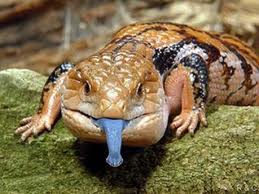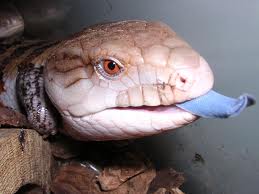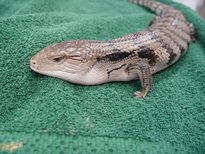Blue Tongued Skink Care (Tiliqua spp.)
Deanne Strat, DVM
Photos and edited by Susan Horton, DVM
Photos and edited by Susan Horton, DVM

Common Species
Pygmy blue tongue skink (T. adelaidensis)
Indonesian blue tongue skink (T. gigas gigas)- gray or gray brown with irregular narrow bands of dark brown across the back
Central blue tongue skink (T. multifasciata)
Blotched blue tongue skink (T. nigrolutea)- black with yellowish, irregularly spotted and striped pattern
Western blue tongue skink (T. occipitalis)- compact with short tail ; reddish brown with light crossbanding
Shingleback blue tongue skink (T. rugosa)
Eastern blue tongue skink (T. scincoides scinoides)
Northern blue tongue skink (T. scincoides intermedia)
Tanimbar blue tongue skink (T. scincoides chimaerea)
Pygmy blue tongue skink (T. adelaidensis)
Indonesian blue tongue skink (T. gigas gigas)- gray or gray brown with irregular narrow bands of dark brown across the back
Central blue tongue skink (T. multifasciata)
Blotched blue tongue skink (T. nigrolutea)- black with yellowish, irregularly spotted and striped pattern
Western blue tongue skink (T. occipitalis)- compact with short tail ; reddish brown with light crossbanding
Shingleback blue tongue skink (T. rugosa)
Eastern blue tongue skink (T. scincoides scinoides)
Northern blue tongue skink (T. scincoides intermedia)
Tanimbar blue tongue skink (T. scincoides chimaerea)

Natural History
Most often found in Australia , Tasmania , Papua New Guinea , Indonesia . They are terrestrial and depending on subspecies they may be found in open woodlands, margins of forests and fields or semi-deserts.
Special Characteristics
They are a stocky reptile with small legs and delicate toes. They have broad, blunt triangular heads with a blue tongue. They are ovoviviparous, which means they produce live young.
Longevity
Up to 30 years in captivity
Size
12-24 inches; 280-510 grams
Behavior
Diurnal, in the wild they spend their day foraging and basking. They are docile and are easy to handle in captivity. If threatened they will puff up and hiss loudly.
Handling
Wash your hands before and after handling. Be sure to support their long body when picking them up so they don’t get nervous. Do not pick them up by their tail as they can drop their tail, though it can regrow.
Most often found in Australia , Tasmania , Papua New Guinea , Indonesia . They are terrestrial and depending on subspecies they may be found in open woodlands, margins of forests and fields or semi-deserts.
Special Characteristics
They are a stocky reptile with small legs and delicate toes. They have broad, blunt triangular heads with a blue tongue. They are ovoviviparous, which means they produce live young.
Longevity
Up to 30 years in captivity
Size
12-24 inches; 280-510 grams
Behavior
Diurnal, in the wild they spend their day foraging and basking. They are docile and are easy to handle in captivity. If threatened they will puff up and hiss loudly.
Handling
Wash your hands before and after handling. Be sure to support their long body when picking them up so they don’t get nervous. Do not pick them up by their tail as they can drop their tail, though it can regrow.

Captive Cage Requirements
Lighting
Ultraviolet B is required to maintain healthy skinks. The best source of UVB is the sun, but this is difficult to provide in captivity since glass filters out UVB light. Instead, a special fluorescent light bulb can be purchased from a reptile shop. This bulb must be placed no more than 12 inches from the basking site (with no glass or plastic between), and should be on a timer to provide about 14 hours of daylight and 10 hours of darkness. It must be replaced every 6-12 months, because even thought the visible light is emitted, the UVB fades. Light bulbs with a screw–in attachment end (even those sold as “full spectrum” bulbs) provide heat, but not UVB.
Temperature
The daytime temperature of the tank should be between 75-85° F with a basking spot of 90-105° F. A heat lamp should be placed over one end of the tank, providing a temperature gradient with one side of the tank warmer than the other. Select the wattage of the bulb to provide the proper temperature within the tank. Under tank heaters are useful to gently raise the overall temperature of the tank, but should be used with a thermostat or rheostat to accommodate changing ambient temperatures. Also be cautious as skinks like to burrow and so there is increased risk of thermal burns if there is no barrier between the glass and heating pad. At night the temperature should drop to 70-75° F. When room temperatures are below 68° F at night, use an under tank heater or a red (infrared) bulb. Obviously, at least two thermometers must be in use to monitor these temperatures, and care must be taken to prevent burns to the lizard. Heating elements can be dangerous if not used properly, and a smoke alarm is recommended.
Lighting
Ultraviolet B is required to maintain healthy skinks. The best source of UVB is the sun, but this is difficult to provide in captivity since glass filters out UVB light. Instead, a special fluorescent light bulb can be purchased from a reptile shop. This bulb must be placed no more than 12 inches from the basking site (with no glass or plastic between), and should be on a timer to provide about 14 hours of daylight and 10 hours of darkness. It must be replaced every 6-12 months, because even thought the visible light is emitted, the UVB fades. Light bulbs with a screw–in attachment end (even those sold as “full spectrum” bulbs) provide heat, but not UVB.
Temperature
The daytime temperature of the tank should be between 75-85° F with a basking spot of 90-105° F. A heat lamp should be placed over one end of the tank, providing a temperature gradient with one side of the tank warmer than the other. Select the wattage of the bulb to provide the proper temperature within the tank. Under tank heaters are useful to gently raise the overall temperature of the tank, but should be used with a thermostat or rheostat to accommodate changing ambient temperatures. Also be cautious as skinks like to burrow and so there is increased risk of thermal burns if there is no barrier between the glass and heating pad. At night the temperature should drop to 70-75° F. When room temperatures are below 68° F at night, use an under tank heater or a red (infrared) bulb. Obviously, at least two thermometers must be in use to monitor these temperatures, and care must be taken to prevent burns to the lizard. Heating elements can be dangerous if not used properly, and a smoke alarm is recommended.

Humidity
Good ventilation is essential, and a hide box with slightly damp substrate (sphagnum moss, loosely piled damp towel) is good for promoting healthy skin shedding. Low humidity will cause improper shedding (dysecdysis), which can cause toe damage.
Water
Provide a water dish that is large enough for the whole skink to soak its body. Lizards often defecate in their water, so it must be replaced daily and the dish disinfected at least once a week.
Enclosure
Adults require at least a 40-55 gal tank, but the longer and wider the better. Substrate can be reptile carpet or towels but they like to burrow so soft woods such as aspen (no pine or cedar) bedding, cypress mulch or recycled newspaper products (Yesterdays Newstm or Carefresh tm) can be used. Be sure that it is not an abrasive substrate for burrowing as it can cause irritation to the skin.
They enjoy exploration, so provide enrichment by offering low braches and logs for them to climb. They also prefer snug hiding areas so be sure to include a half-log or rock cave.
They can be placed outdoors in warmer weather as long as they have access to sunlight, shade and dry areas. They can and will dig so the enclosure should include a fence 50cm below ground.
Feeding
Blue tongue skinks are omnivorous. Their diet should consist of 60% plant material and 40% animal matter. Examples of plant matter include mixed vegetables (i.e. beans, squash, carrots, parsnips), thinly sliced greens (i.e. collards, dandelion, escarole). Berries and fruits (blueberries, cherries, peaches, nectarines, strawberries, pears, banana) should also be provided.
Hatchlings can be started on mealworms, small crickets and pinkie mice. As they grow increase the size of the prey to earth worms, fuzzies and snails. Juveniles are generally fed daily to every other day and adults can be fed once to twice weekly.
Supplements
Food should be dusted with a calcium supplement, without phosphorus. A weekly supplement with a multi-vitamin should be used monthly.
Common illnesses
Parasites, dysecdysis (especially toes), respiratory infections, thiamin deficiency (frozen diet), Metabolic Bone Disease
Sources
Kaplan, Melissa. Herp care Collection, Blue Tongue Skinks. 2009.
Exotics DVM, Vol 8 Issue 6. 2007.
If you have any questions, please feel free to call us at 847-329-8709.
Good ventilation is essential, and a hide box with slightly damp substrate (sphagnum moss, loosely piled damp towel) is good for promoting healthy skin shedding. Low humidity will cause improper shedding (dysecdysis), which can cause toe damage.
Water
Provide a water dish that is large enough for the whole skink to soak its body. Lizards often defecate in their water, so it must be replaced daily and the dish disinfected at least once a week.
Enclosure
Adults require at least a 40-55 gal tank, but the longer and wider the better. Substrate can be reptile carpet or towels but they like to burrow so soft woods such as aspen (no pine or cedar) bedding, cypress mulch or recycled newspaper products (Yesterdays Newstm or Carefresh tm) can be used. Be sure that it is not an abrasive substrate for burrowing as it can cause irritation to the skin.
They enjoy exploration, so provide enrichment by offering low braches and logs for them to climb. They also prefer snug hiding areas so be sure to include a half-log or rock cave.
They can be placed outdoors in warmer weather as long as they have access to sunlight, shade and dry areas. They can and will dig so the enclosure should include a fence 50cm below ground.
Feeding
Blue tongue skinks are omnivorous. Their diet should consist of 60% plant material and 40% animal matter. Examples of plant matter include mixed vegetables (i.e. beans, squash, carrots, parsnips), thinly sliced greens (i.e. collards, dandelion, escarole). Berries and fruits (blueberries, cherries, peaches, nectarines, strawberries, pears, banana) should also be provided.
Hatchlings can be started on mealworms, small crickets and pinkie mice. As they grow increase the size of the prey to earth worms, fuzzies and snails. Juveniles are generally fed daily to every other day and adults can be fed once to twice weekly.
Supplements
Food should be dusted with a calcium supplement, without phosphorus. A weekly supplement with a multi-vitamin should be used monthly.
Common illnesses
Parasites, dysecdysis (especially toes), respiratory infections, thiamin deficiency (frozen diet), Metabolic Bone Disease
Sources
Kaplan, Melissa. Herp care Collection, Blue Tongue Skinks. 2009.
Exotics DVM, Vol 8 Issue 6. 2007.
If you have any questions, please feel free to call us at 847-329-8709.
